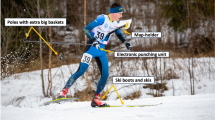Abstract
A continuously waxed ski has been developed that releases a thin film of lubricant under the base of a ski. This replicates the melt water layer observed in snow skis which is caused by frictional and solar heating. The system is particularly effective on artificial (dry) slopes where skiers slide on plastic bristles rather than snow. Speeds comparable to those achieved on snow are achieved using this system and this improves the experience for the skier. Speed enhancements on plastic slopes of up to 50 % have been achieved using solutions of polyethylene glycol in water. There is speed enhancement of approximately 9 % on artificial snow and 2 % on fresh alpine snow. The latter value is highly significant as it can be the difference between winning a medal in ski competitions and finishing outside the top ten. In addition to the quantitative data, qualitative athlete perceptions were also recorded and show that a feel like snow can be achieved on artificial surfaces. Because the lubrication system is attached to the ski, it allows personal performance enhancement irrespective of a water misting system being in operation or not. The design complies with the equipment regulations of the skiing’s international governing body so it can be used in competition.



Similar content being viewed by others
References
Lind D, Sanders SP (1996) The physics of skiing: skiing at the triple point. AIP Press, New York
Barelle C, Ruby A, Tavernier M (2004) Experimental model of the aerodynamic drag coefficient in alpine skiing. J Appl Biomech 20:167–176
Federolf P, Scheiber P, Rauscher E, Schwameder H, Lüthi E, Rhyner H-U, Müller E (2008) Impact of skier actions on the gliding times in alpine skiing 18:790–797
Rogowski I, Leonard D, Gauvrit JY, Lanteri P (2007) Influence of fluorine-based additive content on physical and physicochemical properties of ski gliding wax. Cold Reg Sci Technol 49:145–150
Gambaretto G, Conte L, Fornasieri G, Zarantonelloa C, Toneia D, Sassib A, Bertani R (2003) Synthesis and characterization of a new class of polyfluorinated alkanes: tetrakis(perfluoroalkyl)alkane. J Fluor Chem 121:57–63
Remondet JP, Rebert O, Fayolle L, Stelmakh N, Papelier Y (1997) Performance optimization in alpine skiing: limits and advantages of a simple cinematic model. Sci Sports 12:163–173
von Hertzen R, Holmlund U, Ranta MA (1997) On the velocity optimization in downhill skiing. J Biomech 30:525–529
Sahashi T, Ichino S (1998) Coefficient of kinetic friction of snow skis during turning descents. Jpn J Appl Phys. Part 1 Regul Pap Short Notes Rev Pap 37:720–727
Flanagan T (2009) Alpine skiing technology; faster, higher stronger. Sports Technol 2:5–6
Sahashi T, Ichino S (2001) Carving-turn and edging angle of skis. Sports Eng 4:135–145
Tada N, Hirano Y (2002) In search of the mechanics of a turning alpine ski using snow cutting force measurements. Sports Eng 5:15–22
Jordan SE, Brown CA (2006) Comparing texture characterization parameters on their ability to differentiate ground polyethylene ski bases. Wear 261:398–409
Kuzmin L, Tinnsten M (2008) Hot glide wax treatment and the hardness of the ski running surface. In: Estivalet M, Brisson P (eds) The engineering of sport 7, vol 2. Springer, Paris
Kuzmin L (2010) Interfacial Kinetic Ski Friction. Mid Sweden University Doctoral Thesis, p15 ISBN 978-91-86073-79-4 (miun.diva-portal.org/smash/get/diva2:319312/FULLTEXT01). Accessed 23 Apr 2012
Kuzmin L, Tinnsten M (2006) Dirt adsorption on the ski running surface—quantification and influence on the gliding ability. Sports Eng 9:135–146
Thompson BE, Friess WA, Knapp KN II (2001) Aerodynamics of speed skiers. Sports Eng 4:103–112
Kaps P, Nachbauer W, Mössner M (1996) Determination of kinetic friction and drag area in alpine skiing. Ski Trauma Skiing Saf 10:165–177
Bowden FP, Hughes TP (1939) The mechanism of sliding on ice and snow. Proc R Soc Lond Ser A Math Phys Sci 172:280–298
Mathia TG, Zahouani H, Midol A (1992) Topography, wear, and sliding functions of skis. Int J Mach Tools Manuf 32:263–266
Baurle L, Kaempfer ThU, Szabo’ D, Spencer ND (2007) Sliding friction of polyethylene on snow and ice: contact area and modelling. Cold Reg Sci Technol 47:790–797
Bowden FP, Hughes TP (1939) The mechanism of sliding on ice and snow. Proc R Soc Lond Ser A Math Phys Sci 172:280–298
Buhl D, Fauve M, Rhyner H-U (2001) The kinetic friction of polyethylene on snow: the influence of the snow temperature and the load. Cold Reg Sci Technol 33:133–140
Ducret S, Zahouani H, Midol A, Lanteri P, Mathia TG (2005) Friction and abrasive wear of UHWMPE sliding on ice. Wear 258:26–31
Coupe R, Spells S (2009) Towards a methodology for comparing the effectiveness of different alpine ski waxes. Sports Eng 12:55–62
FIS Specifications for Competition Equipment and Commercial Markings. http://www.fis-ski.com/data/document/edition1011.pdf
Colbeck SC (1988) The kinetic friction of snow. J Glaciol 34:78–86
Colbeck SC, Perovich DK (2004) Temperature effects of black versus white polyethylene bases for snow skis. Cold Reg Sci Tech 39:33–38
Colbeck SC (1996) Capillary bonding of wet surfaces. Surf Coat Technol 81:209–214
Libbrecht K (2006) Ken Libbrecht’s Field Guide to Snowflakes. Voyageur Press, St Pauls MN
Acknowledgments
We thank the Engineering and Physical Sciences Research Council for funding a Senior Media Fellowship to PS which allowed him to dedicate time to the project and to the University of Sheffield for funding to SP. We are grateful to Snowsport England and Stewart Smith of Sharks Ski Club for help in the validations tests and to Sheffield Ski Village and SNO!zone Castleford for use of the ski slope facilities in the UK. We also thank Head Skis Austria GmbH for provision of the alpine test facilities and downhill skis for modification. We are grateful to the athletes who were involved in the testing protocols on the different surfaces: Graham Bell, Phil Smith, Jon Smith, Holly Cutler, Becky Hammond and Hannah Handford-Styring.
Author information
Authors and Affiliations
Corresponding author
Rights and permissions
About this article
Cite this article
Styring, P., Routh, A.F. & Parkinson, S. Friction reduction using self-waxing alpine skis. Sports Eng 15, 117–127 (2012). https://doi.org/10.1007/s12283-012-0095-6
Published:
Issue Date:
DOI: https://doi.org/10.1007/s12283-012-0095-6




